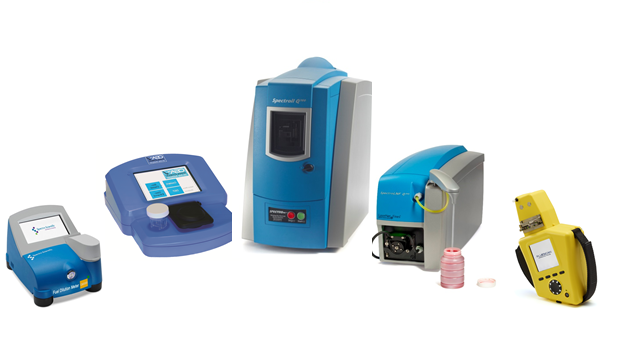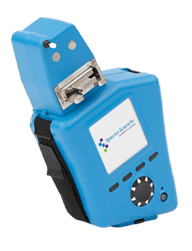Reliability testing is a very important component of new engine development. Engineers need to fully understand and chart the engine lifetime performance under a variety of conditions before mass production may be considered. Many important performance data parameters are collected in real time through the many different types of sensors that are connected to the engine in the test cell and oil analysis is an integral part of the research process.
Comprehensive real time oil analysis can provide critical information about both engine condition and the condition of the lubricant. Due to the limited capabilities of in-line oil sensors that are attached to the test engine, it can be difficult to isolate and identify engine wear data or know the complete condition of the lubricant.

Having the optimum oil analysis instrumentation within close proximity to the test cell will provide that critical data in real time. Choosing the right oil analysis instrument to gather this data is not as obvious as it may sound due to the challenges of the operating environment. During accelerated wear testing, oil analysis reporting may be required at 10 to 15 minutes intervals. This leaves a very limited time for engineers to perform the test and analyze the results once the oil sample has been collected. This puts a premium on sample turnaround time.
This short article will point out the challenges of performing oil analysis testing next to the engine test cell and make recommendations for the proper instruments to perform these tests and report the critical data that is required in any reliability program. Regardless of the types of evaluations that are being performed, oil analysis performed on the engine in the test room needs to meet the following characteristics:
Fast - This is about the time between taking an oil sample from the engine and a report being generated from the analysis for review. Ideally the oil analysis should be performed without any sample preparation to reduce the test time, as well as maintain the integrity of the oil sample. Complex oil preparation techniques, commonly the dilution of the sample with a solvent or titration fluid, introduce the potential for human error as well as increase sample turnaround time.
Easy – The oil analysis instrument should be very easy to operate so that the engineers can focus on the data and not on the data collecting process.
Accurate, repeatable and reproducible - Trending the data results against operating hours, mileage or conditions must be accurate, repeatable and reproducible so that operator errors and other variables are minimized, making the data a pure reflection of true engine condition.
Direct – Direct measurements will help engineers pinpoint a problem quickly. For example, a direct fuel dilution measurement is far better than an indirect measurement, such as looking at the flash point or viscosity. Direct measurements need to be reported without the need to make interpretations of the data.
Comprehensive – Having a complete picture of both the oil and engine condition helps engineers to make decisions with more confidence. Oil condition, engine condition and coolant condition can be quickly determined using location-based fluid analysis.
Some key parameters are explained below along with the recommended testing solutions to meet the above challenges.
Oil condition - Oil condition data is extremely important when performing engine reliability tests. Having oil-related failures while testing engine components for reliability is counter-productive and expensive. Oil change intervals are best achieved by understanding the oil degradation over time, mileage or operating conditions. Typical degradation parameters include Oxidation, Nitration, Sulfation, Total Base Number (TBN) and additive depletion. Oxidation, Nitration and Sulfation are by-products of chemical reactions of the oil with air or fuel during the combustion process. In a commercial oil analysis laboratory, these parameters are measured by looking at the infrared absorption spectrum of the oil. The Total Base Number (TBN) represents the alkaline reserves (Additives) packages in the oil to neutralize acidic contaminants or oxidation by-products in the oil. Unlike in a commercial lab where time consuming titration chemical reagents that use toxic chemicals are used to test the TBN value, it is safer and more efficient to use a pure sample taken directly from the engine for the analysis.

For engine test cell environments, we recommend the Spectro Scientific Fluidscan for all the parameters mentioned above. All parameters are obtained together within one minute without any sample preparation. The Fluidscan Q1000 is a handheld Infrared spectrometer with special calibrations for each type of oil for oxidation, nitration, sulfation and TBN. The Q1000 correlates to lab results very well [1, 2]. One drop (0.02mL) of oil is all that is needed.
Soot - Soot, in diesel engines, is made up of nanometer size hard carbon particles and is deposited in the oil as combustion by-products. As soot globules coagulate into larger particles, engine wear will accelerate. At very high levels soot can cause an increase in the oil viscosity. Higher than normal levels can indicate an improper air/fuel ratio, plugged or defective air intakes or leaking injectors. The Fluidscan Q1000 can test soot up to 3%. If an engine can tolerate a higher percentage of soot in oil, a soot meteris recommended for quick testing (15 seconds for up to 15% of soot). Less than 1 mL of oil is all that is needed [3].
Fuel dilution - Typically is measured in % of weight. Different engines have different alarm limits on fuel dilution. In a commercial laboratory, fuel dilution is commonly measured using Gas Chromatography (GC), which requires complicated calibration with time-consuming sample preparations. In the field, viscosity or flash point testing is commonly used as an indirect indicator of fuel dilution problems. For engine test cell environments we recommend the FDM 6000 Series from Spectro Scientific. It provides a quick and accurate way to directly measure a potential fuel dilution problem within one minute. The FDM 6000 Series will measure fuel dilution from .2% up to 15% without any sample preparation and only uses 0.5 mL of oil to complete the sample process [4].
Break in wear - During the new engine break-in period, larger adhesive (sliding) wear particles are generated at a higher rate than during normal operating conditions. Continuously trending the sliding wear rate helps engineers understand the engine break-in pattern. It is a common challenge to monitor break-in wear particles for engines, as the oil will darken, making it very difficult to do particle analysis without heavy dilution using a solvent. Soot generated from diesel fuel combustion exacerbates the problem.
The Spectro Scientific LaserNet 230 can perform particle analysis on dark oil without dilution. Oils with up to 2% soot, can be analyzed. The LaserNet 230 provides particle size distribution, shape classification and ferrous particle concentration, all within 5 minutes. No sample preparation is needed to monitor the test engine from break-in to test conclusion. Only 3-10 mL of oil sample is needed. The capability of the LaserNet 200 Series to identify and classify particle shape makes it an important research tool for engine test cell applications [5].
Normal wear – Running an engine continuously generates small rubbing wear particles from all moving parts inside. Elemental analysis is the best method to analyze small wear particles and trace the source of wear metals by monitoring metal element concentration. In a commercial lab, elemental analysis is usually performed by either an ICP (Inductive Coupled Plasma) or RDE (Rotating Disc Electrode) spectrometer by exciting the oil and the metal particles  inside the oil, and measuring the atomic emission lines through a grating optics system. ICP is mostly used in large throughput commercial labs and requires sample preparation and special argon gas. RDE is mostly used in smaller labs demanding more flexibility. The Spectro Scientific Spectroil 100 Series is an RDE system that can analyze up to 32 elements, with ppm level accuracy, within 30 seconds without any sample preparation. 3 mL of oil is all that is needed for analysis [6].
inside the oil, and measuring the atomic emission lines through a grating optics system. ICP is mostly used in large throughput commercial labs and requires sample preparation and special argon gas. RDE is mostly used in smaller labs demanding more flexibility. The Spectro Scientific Spectroil 100 Series is an RDE system that can analyze up to 32 elements, with ppm level accuracy, within 30 seconds without any sample preparation. 3 mL of oil is all that is needed for analysis [6].
Coolant condition – The cooling system is critical to engine health. An estimated 60% of engine downtime in the commercial trucking sector is coolant related [7]. Key parameters used to monitor coolant condition are clarity, contamination, glycol content and nitrites. The CoolCheck® 2 UV-Vis and NIR dual spectrometer can be used to test critical coolant parameters such as freeze point, boiling point, water glycol mixture, color, and nitrites in less than a minute.
Elemental analysis is also a critical test for Coolant as monitoring the increase in corrosive wear metals in Coolant, and decrease in additive metals will help understand the performance of the cooling system. The Spectroil 120C is the perfect solution for elemental analysis for coolant with the Coolant calibration program. It measures 24 elements, which covers most common metals found in coolants. Similar to lubricant analysis, it takes 3mL of oil and 30 seconds to measure all the element concentrations.
In summary, all the instruments recommended above provide results that will conform to those from commercial oil analysis. In fact, most of them are used in commercial labs that follow designated ASTM standards. Direct sample analysis using a raw undiluted sample is best. Expediting the sample results with efficient, easy to operate instruments that require no sample preparation will provide fast and accurate results. The simplified user interface greatly reduces human error. When presented with the challenges of engine test cell research, the Spectro Scientific family of fluid analysis instruments can improve the overall efficiency of the project and reduce engine development time by providing accurate fluid sample results in real time.
References:
- White Paper, “Overview of Fluidscan handheld Infrared Oil Analyzer”, Spectro Scientific
- White Paper, “Using Infrared Spectroscopy for the determination of TAN and TBN in Machinery Lubrication Oils”, Spectro Scientific
- White Paper, “Comparing TGA, FTIR and Fixed Filter Infrared Analyzers for Measuring Soot Levels in In-Service Lubricants”, Spectro Scientific
- Apps Note, “Accurate Fuel Dilution in the field using the Q6000 FDM: A comparison to Gas Chromatography”, Randi Price, Spectro Scientific
- “LaserNet Fines – A new tool for the oil analysis toolbox”, David Filicky, Thomas Sebok, Malte Lukas, and Dan Anderson, machinery lubrication.
- White Paper, “Overview of rotating disc electrode (RDE) Optical Emission Spectroscopy for In-Service Oil Analysis”, Spectro Scientific.
- “Learning Coolant Fundamentals”, Paul Fritz, Machinery Lubrication.

